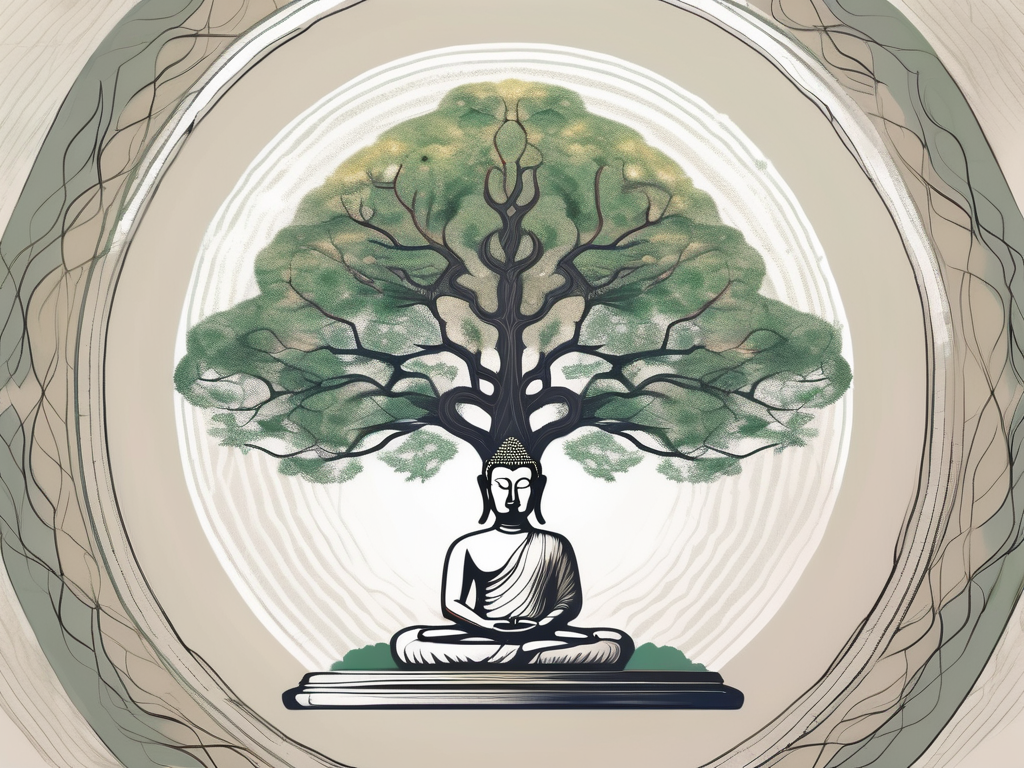Buddhism, one of the world’s major religions, has a rich cultural history that spans over two and a half millennia. From its origins in ancient India to its spread across different countries and its impact on the arts and social values, Buddhism has left an indelible mark on the world. Understanding the culture of Buddha requires exploring the origins of Buddhism, its core beliefs and teachings, as well as its spread and adaptation in modern times.
Understanding the Origins of Buddhism
The birthplace of Buddha and the emergence of Buddhism hold great significance in understanding the culture surrounding this religion. Siddhartha Gautama, who later became known as Buddha, was born in Lumbini, Nepal, in the 6th century BCE. His quest for enlightenment and the subsequent founding of Buddhism shaped the cultural landscape of India and beyond.
The Birthplace of Buddha and Buddhism
Lumbini, a small town in Nepal, is believed to be the birthplace of Buddha. Today, it is a pilgrimage site for millions of Buddhists from all over the world. The sacred Bodh Gaya in India, where Buddha attained enlightenment, also holds deep cultural significance, attracting visitors seeking spiritual enlightenment and a deep connection to Buddhist teachings.
When visiting Lumbini, pilgrims are greeted by the serene beauty of the surrounding landscape. The town is nestled in the foothills of the Himalayas, with lush green fields and tranquil gardens. The air is filled with a sense of peace and tranquility, as if the very essence of Buddha’s teachings permeates the atmosphere.
Walking through the sacred site, visitors can explore the Maya Devi Temple, which marks the exact spot where Buddha is believed to have been born. The temple is adorned with intricate carvings and statues, depicting scenes from Buddha’s life and teachings. Pilgrims offer prayers and light incense, seeking blessings and guidance on their spiritual journey.
Just a short distance away from Lumbini, lies Bodh Gaya, the place where Buddha attained enlightenment. This sacred site is home to the famous Mahabodhi Temple, a UNESCO World Heritage Site. The temple complex is a magnificent structure, with its towering spire and intricate architectural details. Inside, the main shrine houses a large gilded statue of Buddha, radiating a sense of serenity and wisdom.
Historical Context of Buddhism’s Emergence
Buddhism emerged in a time of great social and spiritual change in ancient India. It was a period marked by deep socio-political discord and a yearning for spiritual liberation. The teachings of Buddha, which centered around the alleviation of suffering and the pursuit of enlightenment, resonated with many seeking a path to a more fulfilling existence.
During this time, the Indian subcontinent was divided into numerous kingdoms, each vying for power and dominance. The caste system, which rigidly stratified society, created a sense of inequality and oppression. People from all walks of life, including the lower castes, were drawn to Buddha’s teachings, as they offered a path to liberation that transcended social barriers.
Buddhism also emerged in response to the prevailing religious practices of the time, which were often characterized by ritualistic ceremonies and sacrifices. Buddha emphasized the importance of personal experience and inner transformation, rather than relying on external rituals. This shift in focus resonated with those who sought a more direct and personal connection with the divine.
As Buddhism gained popularity, it spread beyond the borders of India, reaching countries such as Sri Lanka, China, Japan, and Tibet. Each region embraced the teachings of Buddha, incorporating them into their own unique cultural and religious traditions. Today, Buddhism continues to thrive as a major world religion, with millions of followers around the globe.
The Core Beliefs and Teachings of Buddhism
At the heart of Buddhism lie the Four Noble Truths and the Eightfold Path. These teachings form the foundation of Buddhist philosophy and shape its followers’ understanding of reality and the path to liberation.
Buddhism, one of the world’s major religions, originated in ancient India and was founded by Siddhartha Gautama, who later became known as the Buddha. The teachings of Buddhism have spread across the globe, influencing countless individuals and cultures.
The Four Noble Truths encapsulate Buddha’s teachings on suffering, its causes, and how to overcome it. They invite introspection and a deeper understanding of the human condition, offering a framework for personal growth and transformation.
The First Noble Truth acknowledges the existence of suffering in the world. It recognizes that life is inherently unsatisfactory, filled with various forms of physical, emotional, and mental pain. This truth encourages individuals to confront the realities of life and develop a compassionate response to suffering.
The Second Noble Truth explores the causes of suffering. It teaches that attachment, desire, and ignorance are the root causes of human suffering. By recognizing and understanding these causes, individuals can begin to alleviate their suffering and find a path to liberation.
The Third Noble Truth offers hope by proclaiming that suffering can be overcome. It emphasizes that liberation from suffering is attainable through the cessation of attachment and desire. By letting go of cravings and attachments, individuals can experience true peace and freedom.
The Fourth Noble Truth presents the Eightfold Path as the means to end suffering. It outlines a comprehensive guide to living a meaningful and fulfilling life. The Eightfold Path encompasses ethical conduct, meditation, and wisdom, providing practical steps for living a compassionate and mindful life.
The Eightfold Path, often referred to as the Middle Way, emphasizes the importance of finding balance and avoiding extremes. It consists of eight interconnected factors that work together to cultivate wisdom, ethical behavior, and mental discipline.
The first factor of the Eightfold Path is Right View, which involves understanding the nature of reality and the interconnectedness of all things. Right Intention follows, encouraging individuals to cultivate wholesome intentions and renounce harmful desires.
Right Speech, the third factor, emphasizes the importance of truthful, kind, and compassionate communication. Right Action and Right Livelihood promote ethical conduct and responsible livelihood, encouraging individuals to act in ways that do not harm others.
The next three factors of the Eightfold Path focus on mental discipline and meditation. Right Effort encourages individuals to cultivate positive mental states and abandon negative ones. Right Mindfulness involves being fully present and aware of one’s thoughts, feelings, and actions. Right Concentration refers to the development of deep concentration and focused attention through meditation.
The final factor of the Eightfold Path is Right Understanding, which represents the culmination of wisdom and insight. It involves understanding the true nature of reality, the impermanence of all things, and the interconnectedness of life.
By following the Eightfold Path, individuals can cultivate wisdom, compassion, and mindfulness, leading to personal growth and liberation from suffering. Buddhism offers a profound and practical philosophy for navigating the complexities of life and finding inner peace.
The Spread of Buddhism Across Cultures
Buddhism’s influence expanded beyond India’s borders, reaching diverse regions of Asia, including China, Japan, and Southeast Asian countries.
As Buddhism spread throughout Asia, it encountered local beliefs and cultural practices, resulting in unique amalgamations of Buddhism with indigenous traditions. This process of adaptation and syncretism gave rise to fascinating variations of Buddhism in different regions.
In China, Buddhism took root and flourished, blending with Confucianism and Taoism. This fusion created a distinct form of Buddhism known as Chan, which later evolved into Zen Buddhism in Japan. Zen Buddhism emphasized direct experience and meditation, and it became deeply ingrained in Japanese culture, influencing art, tea ceremonies, and martial arts.
Meanwhile, in Southeast Asian countries like Thailand, Cambodia, and Myanmar, Buddhism integrated with local animistic beliefs and practices. This resulted in the development of Theravada Buddhism, which emphasizes individual enlightenment and the pursuit of nirvana through meditation and ethical living.
Buddhism’s Influence in Western Cultures
In recent centuries, Buddhism has gained a following in Western cultures, attracting individuals searching for spiritual growth and alternative worldviews. The adoption of Buddhist meditation practices and philosophies has influenced various fields, including psychology, neuroscience, and mindfulness-based therapies.
One example of Buddhism’s impact in the West is the introduction of mindfulness meditation. Derived from Buddhist meditation techniques, mindfulness has become a popular practice in psychology and mental health. It has been incorporated into therapies for stress reduction, anxiety, and depression, offering individuals practical tools for self-awareness and emotional well-being.
Moreover, Buddhism’s emphasis on compassion and interconnectedness has influenced social and environmental activism in Western cultures. Buddhist principles of non-violence and ecological awareness have inspired individuals and organizations to advocate for peace, social justice, and sustainable living.
Another area where Buddhism has made significant inroads in the West is in the field of neuroscience. Scientists have been studying the effects of meditation on the brain, exploring how Buddhist practices can enhance attention, emotional regulation, and overall well-being. These studies have shed light on the neuroplasticity of the brain and have led to the development of mindfulness-based interventions in clinical settings.
Overall, Buddhism’s journey across cultures has been a dynamic and transformative process. As it encountered different societies and worldviews, it adapted and evolved, leaving a lasting impact on the spiritual, cultural, and intellectual landscapes of various regions.
The Cultural Impact of Buddhism
Buddhism’s cultural impact extends beyond religious practices, permeating the arts, social values, and ethical frameworks of societies.
One of the most fascinating aspects of Buddhism’s cultural impact is its influence on the arts. From intricately designed Buddhist temples and sculptures to paintings and poetry, Buddhism has inspired and influenced various artistic expressions across the globe. The tranquil aesthetics and meditative quality of Buddhist art reflect the core values of the religion. Artists have sought to capture the essence of Buddhist teachings through their creative works, creating a visual representation of the spiritual journey and the quest for enlightenment.
For centuries, Buddhist art has served as a medium for spiritual contemplation and reflection. The intricate details and symbolic imagery found in Buddhist sculptures and paintings invite viewers to delve deeper into the teachings and philosophy of Buddhism. These artistic expressions not only serve as a source of inspiration and beauty but also as a means of conveying profound spiritual concepts to a wider audience.
Buddhism’s Influence on Social and Ethical Values
Buddhist teachings emphasize compassion, interconnectedness, and non-violence. These principles have influenced social and ethical values in many cultures, promoting tolerance, empathy, and environmental mindfulness.
The influence of Buddhism on social and ethical values can be seen in various aspects of daily life. The concept of compassion, central to Buddhist teachings, has inspired individuals and communities to extend kindness and understanding towards others. This emphasis on compassion has led to the development of charitable organizations and initiatives aimed at alleviating suffering and promoting social justice.
Furthermore, Buddhism’s emphasis on interconnectedness has fostered a sense of global citizenship and a recognition of the interdependence of all living beings. This awareness has prompted individuals and societies to adopt more sustainable and environmentally friendly practices, recognizing the impact of their actions on the planet and future generations.
Non-violence, another key principle in Buddhism, has influenced the promotion of peace and conflict resolution in various societies. Buddhist teachings encourage individuals to seek peaceful solutions to conflicts, to practice forgiveness, and to cultivate inner peace as a means of contributing to a more harmonious and just world.
In conclusion, the cultural impact of Buddhism is far-reaching and profound. From its influence on the arts to its impact on social and ethical values, Buddhism has left an indelible mark on societies around the world. Its teachings continue to inspire individuals to seek enlightenment and to cultivate compassion, interconnectedness, and non-violence in their lives.
Modern Buddhism and Cultural Adaptation
Buddhism continues to evolve and adapt to the modern world, as practitioners seek to integrate its teachings into their lives and engage in interfaith dialogue.
Contemporary Buddhist Practices
In the 21st century, a range of Buddhist practices has emerged, catering to the needs of diverse individuals and societies. From mindfulness retreats to engaged Buddhism, practitioners are finding innovative ways to immerse themselves in Buddhist teachings while navigating the complexities of contemporary life.
Buddhism and Interfaith Dialogue
Buddhism’s compatibility with other religious and philosophical traditions has led to fruitful interfaith dialogue and cooperation. Buddhists, alongside individuals from various backgrounds, are finding common ground and exploring shared values to foster understanding and create a more harmonious society.
In conclusion, the culture of Buddha encompasses a vast array of historical, philosophical, artistic, and ethical elements. From its origins in ancient India to its far-reaching influence across cultures and its adaptation in the modern world, Buddhism continues to shape societies and inspire individuals seeking spiritual growth and inner peace.












